Health and Social Care for African Migrants in Victoria, Australia
VerifiedAdded on 2020/03/07
|9
|1985
|78
Report
AI Summary
This report provides an in-depth analysis of the Australian health and social care system, with a specific focus on the health and well-being of African migrants residing in Victoria. The introduction highlights the diverse challenges in designing and offering health care across different areas and demographics. The report identifies childhood obesity, perinatal health issues, and HIV exposure as key health concerns within this subpopulation. Barriers to accessing health services, including language, cultural diversity, and low health literacy, are discussed. Strategies to overcome these barriers, such as cultural competence training and community-based health promotion programs, are presented. The report also examines deficits in the provision of care for chronic illnesses, such as type II diabetes, and proposes a fictitious health service, the 'African Chronic Disease Package,' designed to address these deficits. This service includes patient testing, medication distribution, and lifestyle education, with details on the venue, funding, staffing, accreditation, payment methods, and program evaluation metrics. The report concludes with a comprehensive list of references.
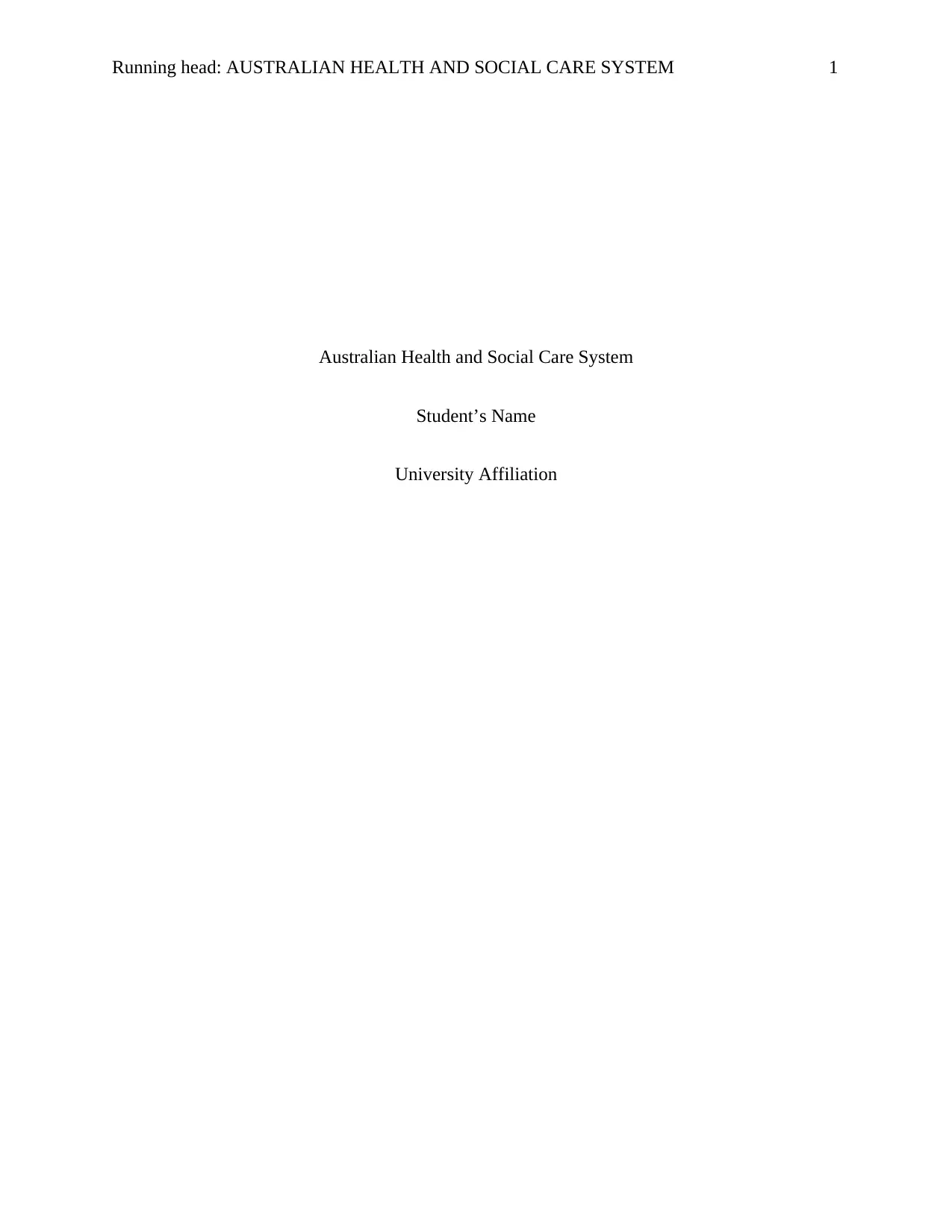
Running head: AUSTRALIAN HEALTH AND SOCIAL CARE SYSTEM 1
Australian Health and Social Care System
Student’s Name
University Affiliation
Australian Health and Social Care System
Student’s Name
University Affiliation
Paraphrase This Document
Need a fresh take? Get an instant paraphrase of this document with our AI Paraphraser
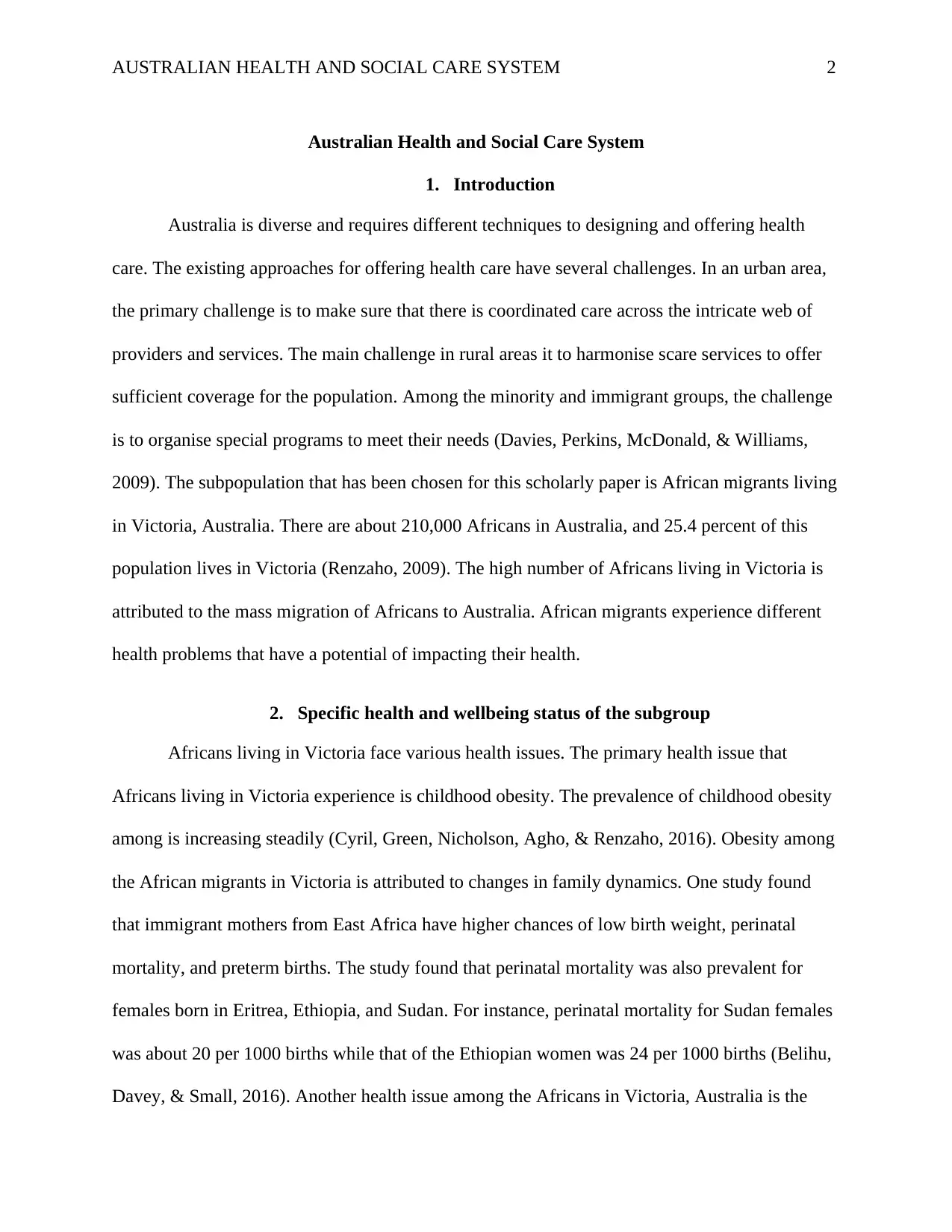
AUSTRALIAN HEALTH AND SOCIAL CARE SYSTEM 2
Australian Health and Social Care System
1. Introduction
Australia is diverse and requires different techniques to designing and offering health
care. The existing approaches for offering health care have several challenges. In an urban area,
the primary challenge is to make sure that there is coordinated care across the intricate web of
providers and services. The main challenge in rural areas it to harmonise scare services to offer
sufficient coverage for the population. Among the minority and immigrant groups, the challenge
is to organise special programs to meet their needs (Davies, Perkins, McDonald, & Williams,
2009). The subpopulation that has been chosen for this scholarly paper is African migrants living
in Victoria, Australia. There are about 210,000 Africans in Australia, and 25.4 percent of this
population lives in Victoria (Renzaho, 2009). The high number of Africans living in Victoria is
attributed to the mass migration of Africans to Australia. African migrants experience different
health problems that have a potential of impacting their health.
2. Specific health and wellbeing status of the subgroup
Africans living in Victoria face various health issues. The primary health issue that
Africans living in Victoria experience is childhood obesity. The prevalence of childhood obesity
among is increasing steadily (Cyril, Green, Nicholson, Agho, & Renzaho, 2016). Obesity among
the African migrants in Victoria is attributed to changes in family dynamics. One study found
that immigrant mothers from East Africa have higher chances of low birth weight, perinatal
mortality, and preterm births. The study found that perinatal mortality was also prevalent for
females born in Eritrea, Ethiopia, and Sudan. For instance, perinatal mortality for Sudan females
was about 20 per 1000 births while that of the Ethiopian women was 24 per 1000 births (Belihu,
Davey, & Small, 2016). Another health issue among the Africans in Victoria, Australia is the
Australian Health and Social Care System
1. Introduction
Australia is diverse and requires different techniques to designing and offering health
care. The existing approaches for offering health care have several challenges. In an urban area,
the primary challenge is to make sure that there is coordinated care across the intricate web of
providers and services. The main challenge in rural areas it to harmonise scare services to offer
sufficient coverage for the population. Among the minority and immigrant groups, the challenge
is to organise special programs to meet their needs (Davies, Perkins, McDonald, & Williams,
2009). The subpopulation that has been chosen for this scholarly paper is African migrants living
in Victoria, Australia. There are about 210,000 Africans in Australia, and 25.4 percent of this
population lives in Victoria (Renzaho, 2009). The high number of Africans living in Victoria is
attributed to the mass migration of Africans to Australia. African migrants experience different
health problems that have a potential of impacting their health.
2. Specific health and wellbeing status of the subgroup
Africans living in Victoria face various health issues. The primary health issue that
Africans living in Victoria experience is childhood obesity. The prevalence of childhood obesity
among is increasing steadily (Cyril, Green, Nicholson, Agho, & Renzaho, 2016). Obesity among
the African migrants in Victoria is attributed to changes in family dynamics. One study found
that immigrant mothers from East Africa have higher chances of low birth weight, perinatal
mortality, and preterm births. The study found that perinatal mortality was also prevalent for
females born in Eritrea, Ethiopia, and Sudan. For instance, perinatal mortality for Sudan females
was about 20 per 1000 births while that of the Ethiopian women was 24 per 1000 births (Belihu,
Davey, & Small, 2016). Another health issue among the Africans in Victoria, Australia is the
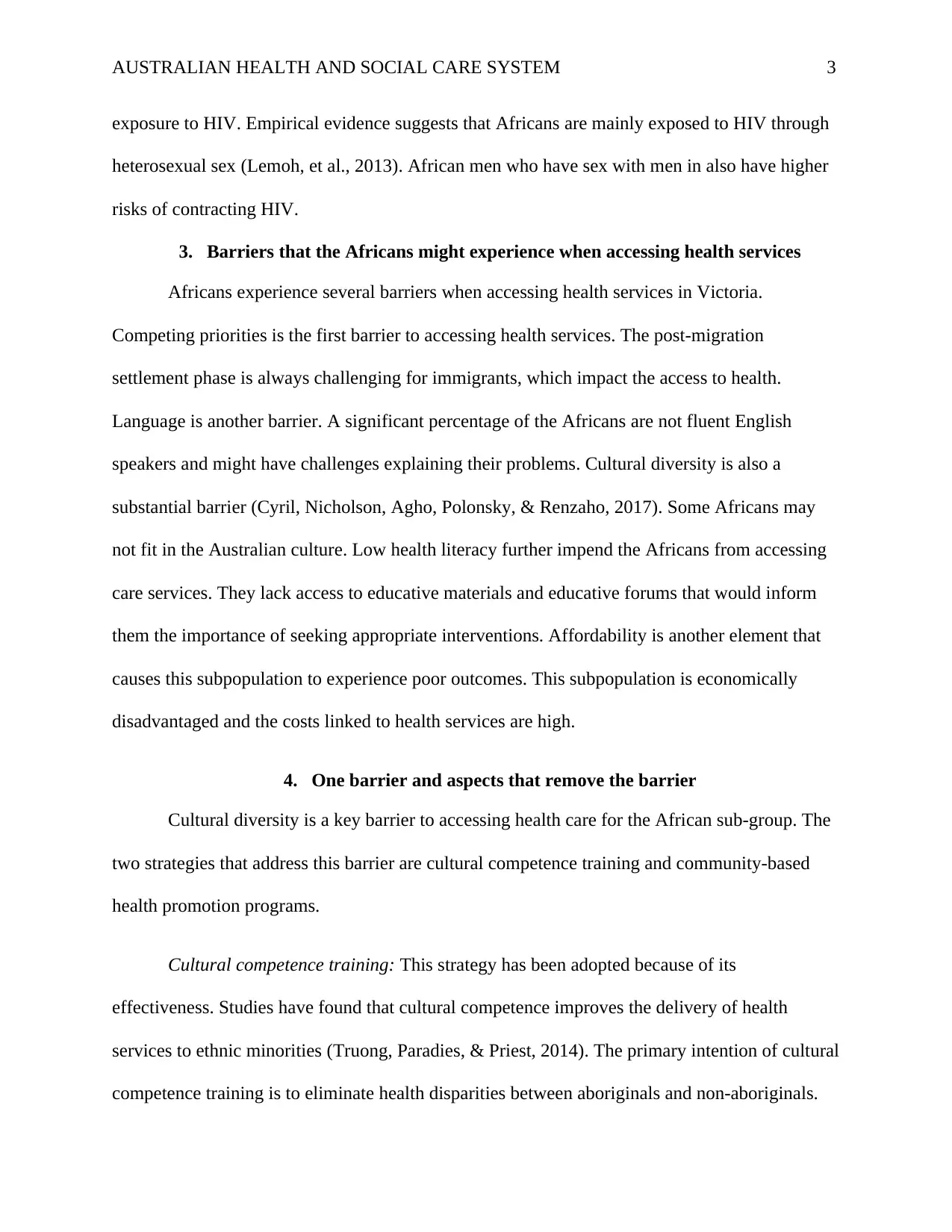
AUSTRALIAN HEALTH AND SOCIAL CARE SYSTEM 3
exposure to HIV. Empirical evidence suggests that Africans are mainly exposed to HIV through
heterosexual sex (Lemoh, et al., 2013). African men who have sex with men in also have higher
risks of contracting HIV.
3. Barriers that the Africans might experience when accessing health services
Africans experience several barriers when accessing health services in Victoria.
Competing priorities is the first barrier to accessing health services. The post-migration
settlement phase is always challenging for immigrants, which impact the access to health.
Language is another barrier. A significant percentage of the Africans are not fluent English
speakers and might have challenges explaining their problems. Cultural diversity is also a
substantial barrier (Cyril, Nicholson, Agho, Polonsky, & Renzaho, 2017). Some Africans may
not fit in the Australian culture. Low health literacy further impend the Africans from accessing
care services. They lack access to educative materials and educative forums that would inform
them the importance of seeking appropriate interventions. Affordability is another element that
causes this subpopulation to experience poor outcomes. This subpopulation is economically
disadvantaged and the costs linked to health services are high.
4. One barrier and aspects that remove the barrier
Cultural diversity is a key barrier to accessing health care for the African sub-group. The
two strategies that address this barrier are cultural competence training and community-based
health promotion programs.
Cultural competence training: This strategy has been adopted because of its
effectiveness. Studies have found that cultural competence improves the delivery of health
services to ethnic minorities (Truong, Paradies, & Priest, 2014). The primary intention of cultural
competence training is to eliminate health disparities between aboriginals and non-aboriginals.
exposure to HIV. Empirical evidence suggests that Africans are mainly exposed to HIV through
heterosexual sex (Lemoh, et al., 2013). African men who have sex with men in also have higher
risks of contracting HIV.
3. Barriers that the Africans might experience when accessing health services
Africans experience several barriers when accessing health services in Victoria.
Competing priorities is the first barrier to accessing health services. The post-migration
settlement phase is always challenging for immigrants, which impact the access to health.
Language is another barrier. A significant percentage of the Africans are not fluent English
speakers and might have challenges explaining their problems. Cultural diversity is also a
substantial barrier (Cyril, Nicholson, Agho, Polonsky, & Renzaho, 2017). Some Africans may
not fit in the Australian culture. Low health literacy further impend the Africans from accessing
care services. They lack access to educative materials and educative forums that would inform
them the importance of seeking appropriate interventions. Affordability is another element that
causes this subpopulation to experience poor outcomes. This subpopulation is economically
disadvantaged and the costs linked to health services are high.
4. One barrier and aspects that remove the barrier
Cultural diversity is a key barrier to accessing health care for the African sub-group. The
two strategies that address this barrier are cultural competence training and community-based
health promotion programs.
Cultural competence training: This strategy has been adopted because of its
effectiveness. Studies have found that cultural competence improves the delivery of health
services to ethnic minorities (Truong, Paradies, & Priest, 2014). The primary intention of cultural
competence training is to eliminate health disparities between aboriginals and non-aboriginals.
⊘ This is a preview!⊘
Do you want full access?
Subscribe today to unlock all pages.

Trusted by 1+ million students worldwide
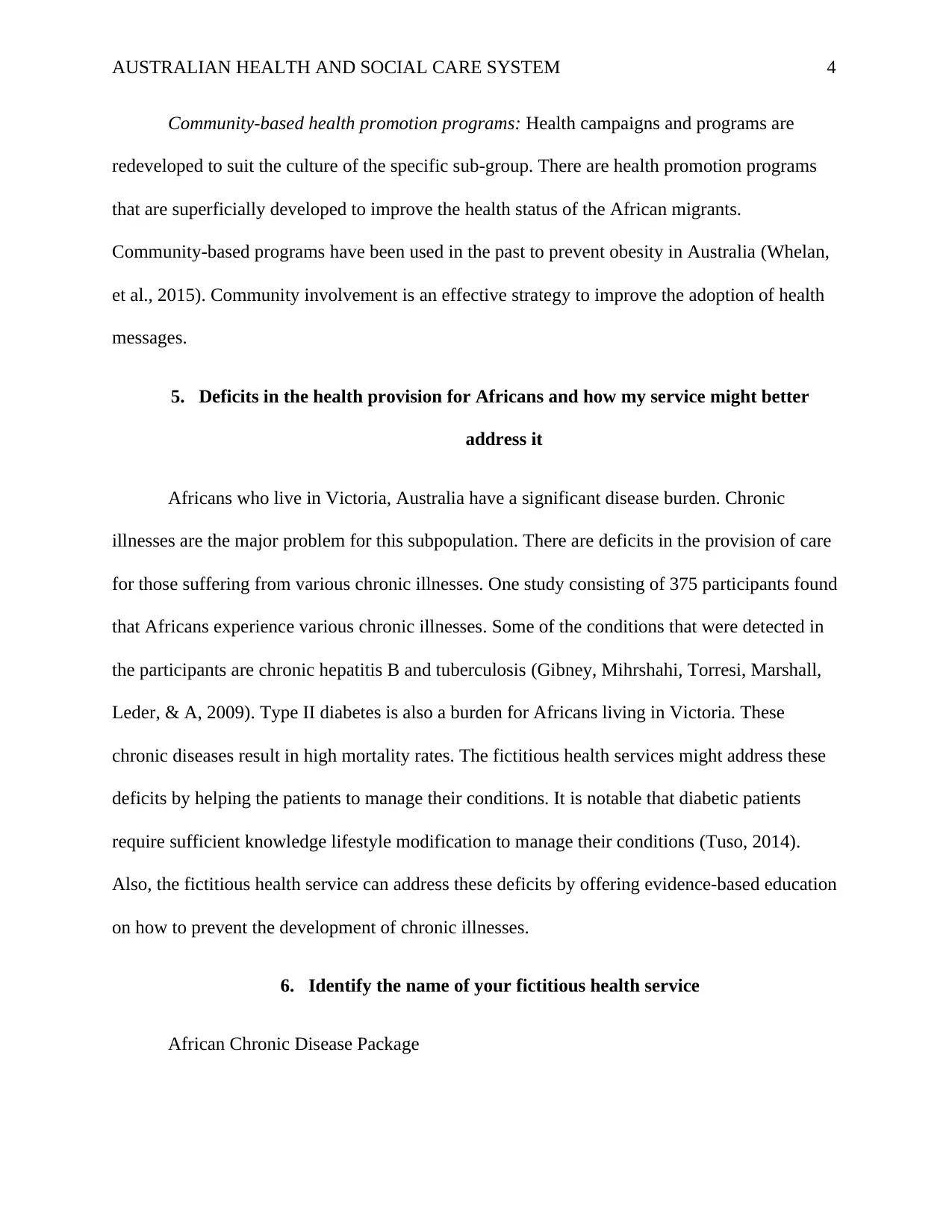
AUSTRALIAN HEALTH AND SOCIAL CARE SYSTEM 4
Community-based health promotion programs: Health campaigns and programs are
redeveloped to suit the culture of the specific sub-group. There are health promotion programs
that are superficially developed to improve the health status of the African migrants.
Community-based programs have been used in the past to prevent obesity in Australia (Whelan,
et al., 2015). Community involvement is an effective strategy to improve the adoption of health
messages.
5. Deficits in the health provision for Africans and how my service might better
address it
Africans who live in Victoria, Australia have a significant disease burden. Chronic
illnesses are the major problem for this subpopulation. There are deficits in the provision of care
for those suffering from various chronic illnesses. One study consisting of 375 participants found
that Africans experience various chronic illnesses. Some of the conditions that were detected in
the participants are chronic hepatitis B and tuberculosis (Gibney, Mihrshahi, Torresi, Marshall,
Leder, & A, 2009). Type II diabetes is also a burden for Africans living in Victoria. These
chronic diseases result in high mortality rates. The fictitious health services might address these
deficits by helping the patients to manage their conditions. It is notable that diabetic patients
require sufficient knowledge lifestyle modification to manage their conditions (Tuso, 2014).
Also, the fictitious health service can address these deficits by offering evidence-based education
on how to prevent the development of chronic illnesses.
6. Identify the name of your fictitious health service
African Chronic Disease Package
Community-based health promotion programs: Health campaigns and programs are
redeveloped to suit the culture of the specific sub-group. There are health promotion programs
that are superficially developed to improve the health status of the African migrants.
Community-based programs have been used in the past to prevent obesity in Australia (Whelan,
et al., 2015). Community involvement is an effective strategy to improve the adoption of health
messages.
5. Deficits in the health provision for Africans and how my service might better
address it
Africans who live in Victoria, Australia have a significant disease burden. Chronic
illnesses are the major problem for this subpopulation. There are deficits in the provision of care
for those suffering from various chronic illnesses. One study consisting of 375 participants found
that Africans experience various chronic illnesses. Some of the conditions that were detected in
the participants are chronic hepatitis B and tuberculosis (Gibney, Mihrshahi, Torresi, Marshall,
Leder, & A, 2009). Type II diabetes is also a burden for Africans living in Victoria. These
chronic diseases result in high mortality rates. The fictitious health services might address these
deficits by helping the patients to manage their conditions. It is notable that diabetic patients
require sufficient knowledge lifestyle modification to manage their conditions (Tuso, 2014).
Also, the fictitious health service can address these deficits by offering evidence-based education
on how to prevent the development of chronic illnesses.
6. Identify the name of your fictitious health service
African Chronic Disease Package
Paraphrase This Document
Need a fresh take? Get an instant paraphrase of this document with our AI Paraphraser
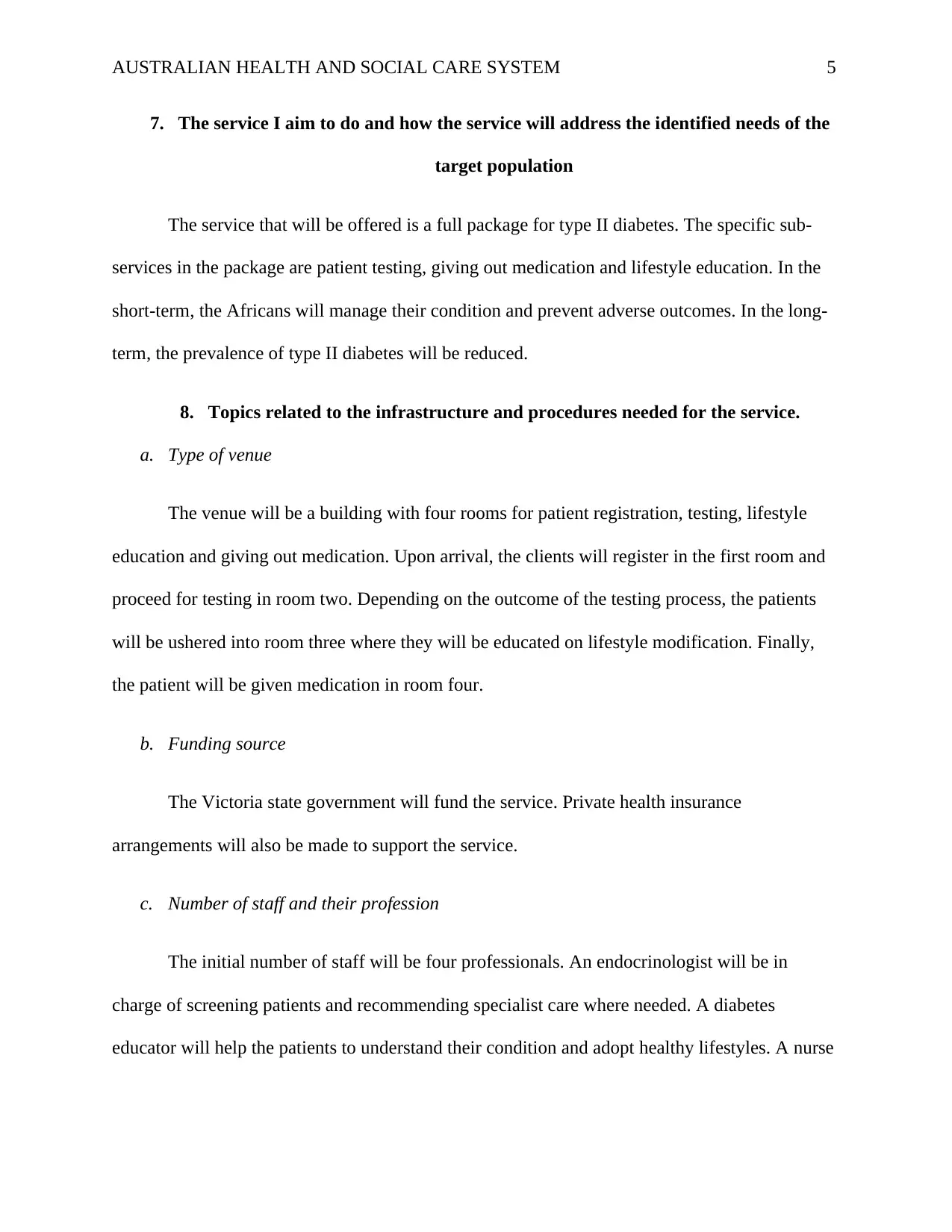
AUSTRALIAN HEALTH AND SOCIAL CARE SYSTEM 5
7. The service I aim to do and how the service will address the identified needs of the
target population
The service that will be offered is a full package for type II diabetes. The specific sub-
services in the package are patient testing, giving out medication and lifestyle education. In the
short-term, the Africans will manage their condition and prevent adverse outcomes. In the long-
term, the prevalence of type II diabetes will be reduced.
8. Topics related to the infrastructure and procedures needed for the service.
a. Type of venue
The venue will be a building with four rooms for patient registration, testing, lifestyle
education and giving out medication. Upon arrival, the clients will register in the first room and
proceed for testing in room two. Depending on the outcome of the testing process, the patients
will be ushered into room three where they will be educated on lifestyle modification. Finally,
the patient will be given medication in room four.
b. Funding source
The Victoria state government will fund the service. Private health insurance
arrangements will also be made to support the service.
c. Number of staff and their profession
The initial number of staff will be four professionals. An endocrinologist will be in
charge of screening patients and recommending specialist care where needed. A diabetes
educator will help the patients to understand their condition and adopt healthy lifestyles. A nurse
7. The service I aim to do and how the service will address the identified needs of the
target population
The service that will be offered is a full package for type II diabetes. The specific sub-
services in the package are patient testing, giving out medication and lifestyle education. In the
short-term, the Africans will manage their condition and prevent adverse outcomes. In the long-
term, the prevalence of type II diabetes will be reduced.
8. Topics related to the infrastructure and procedures needed for the service.
a. Type of venue
The venue will be a building with four rooms for patient registration, testing, lifestyle
education and giving out medication. Upon arrival, the clients will register in the first room and
proceed for testing in room two. Depending on the outcome of the testing process, the patients
will be ushered into room three where they will be educated on lifestyle modification. Finally,
the patient will be given medication in room four.
b. Funding source
The Victoria state government will fund the service. Private health insurance
arrangements will also be made to support the service.
c. Number of staff and their profession
The initial number of staff will be four professionals. An endocrinologist will be in
charge of screening patients and recommending specialist care where needed. A diabetes
educator will help the patients to understand their condition and adopt healthy lifestyles. A nurse
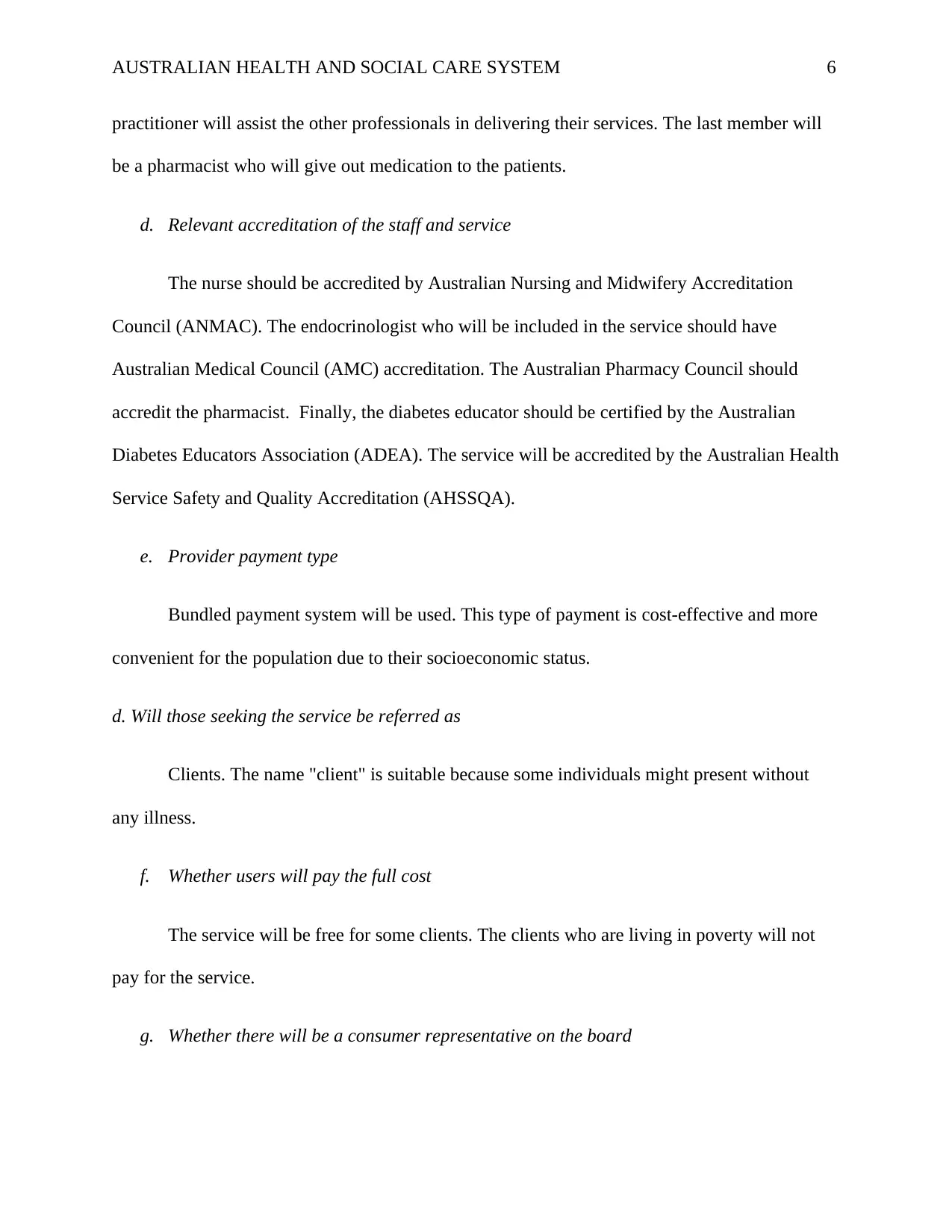
AUSTRALIAN HEALTH AND SOCIAL CARE SYSTEM 6
practitioner will assist the other professionals in delivering their services. The last member will
be a pharmacist who will give out medication to the patients.
d. Relevant accreditation of the staff and service
The nurse should be accredited by Australian Nursing and Midwifery Accreditation
Council (ANMAC). The endocrinologist who will be included in the service should have
Australian Medical Council (AMC) accreditation. The Australian Pharmacy Council should
accredit the pharmacist. Finally, the diabetes educator should be certified by the Australian
Diabetes Educators Association (ADEA). The service will be accredited by the Australian Health
Service Safety and Quality Accreditation (AHSSQA).
e. Provider payment type
Bundled payment system will be used. This type of payment is cost-effective and more
convenient for the population due to their socioeconomic status.
d. Will those seeking the service be referred as
Clients. The name "client" is suitable because some individuals might present without
any illness.
f. Whether users will pay the full cost
The service will be free for some clients. The clients who are living in poverty will not
pay for the service.
g. Whether there will be a consumer representative on the board
practitioner will assist the other professionals in delivering their services. The last member will
be a pharmacist who will give out medication to the patients.
d. Relevant accreditation of the staff and service
The nurse should be accredited by Australian Nursing and Midwifery Accreditation
Council (ANMAC). The endocrinologist who will be included in the service should have
Australian Medical Council (AMC) accreditation. The Australian Pharmacy Council should
accredit the pharmacist. Finally, the diabetes educator should be certified by the Australian
Diabetes Educators Association (ADEA). The service will be accredited by the Australian Health
Service Safety and Quality Accreditation (AHSSQA).
e. Provider payment type
Bundled payment system will be used. This type of payment is cost-effective and more
convenient for the population due to their socioeconomic status.
d. Will those seeking the service be referred as
Clients. The name "client" is suitable because some individuals might present without
any illness.
f. Whether users will pay the full cost
The service will be free for some clients. The clients who are living in poverty will not
pay for the service.
g. Whether there will be a consumer representative on the board
⊘ This is a preview!⊘
Do you want full access?
Subscribe today to unlock all pages.

Trusted by 1+ million students worldwide
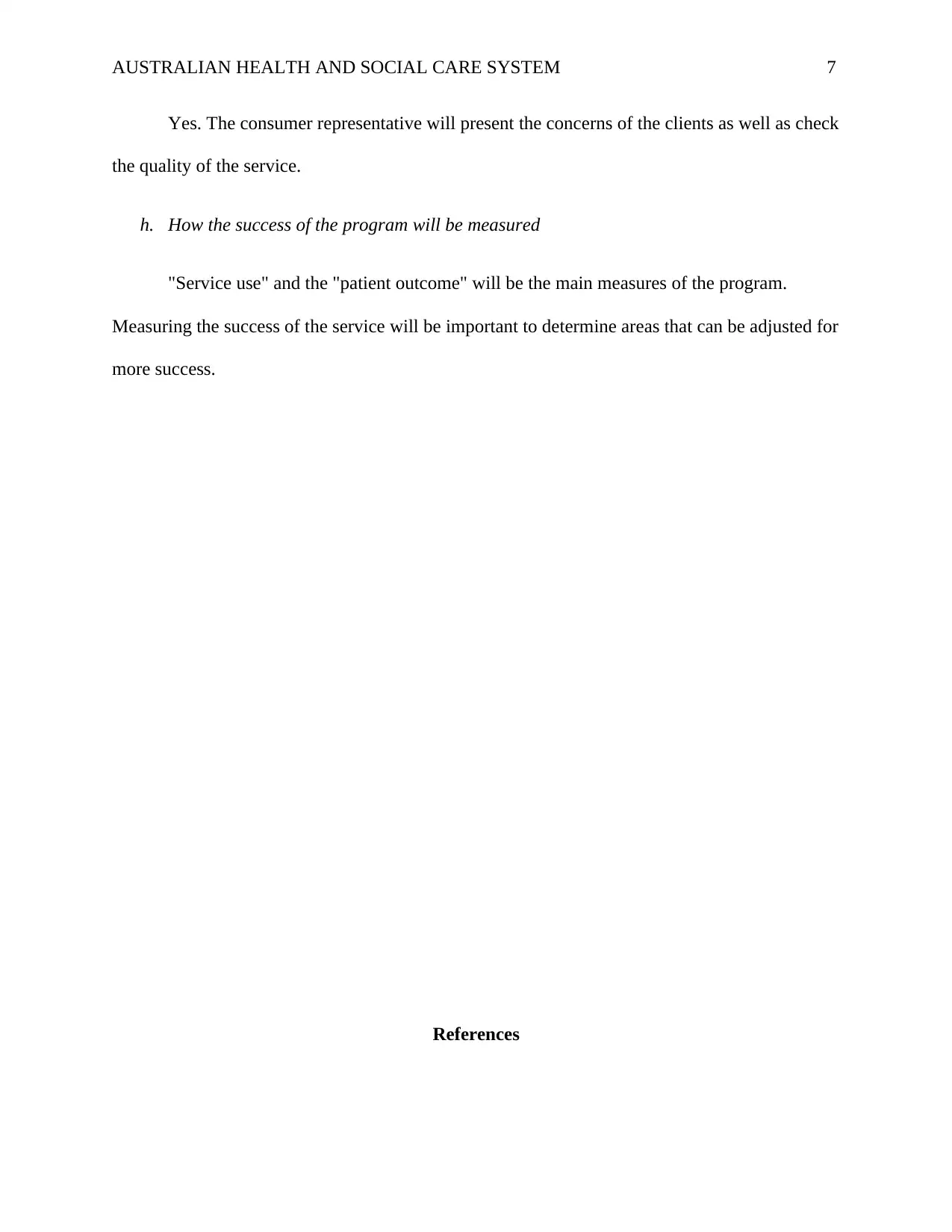
AUSTRALIAN HEALTH AND SOCIAL CARE SYSTEM 7
Yes. The consumer representative will present the concerns of the clients as well as check
the quality of the service.
h. How the success of the program will be measured
"Service use" and the "patient outcome" will be the main measures of the program.
Measuring the success of the service will be important to determine areas that can be adjusted for
more success.
References
Yes. The consumer representative will present the concerns of the clients as well as check
the quality of the service.
h. How the success of the program will be measured
"Service use" and the "patient outcome" will be the main measures of the program.
Measuring the success of the service will be important to determine areas that can be adjusted for
more success.
References
Paraphrase This Document
Need a fresh take? Get an instant paraphrase of this document with our AI Paraphraser
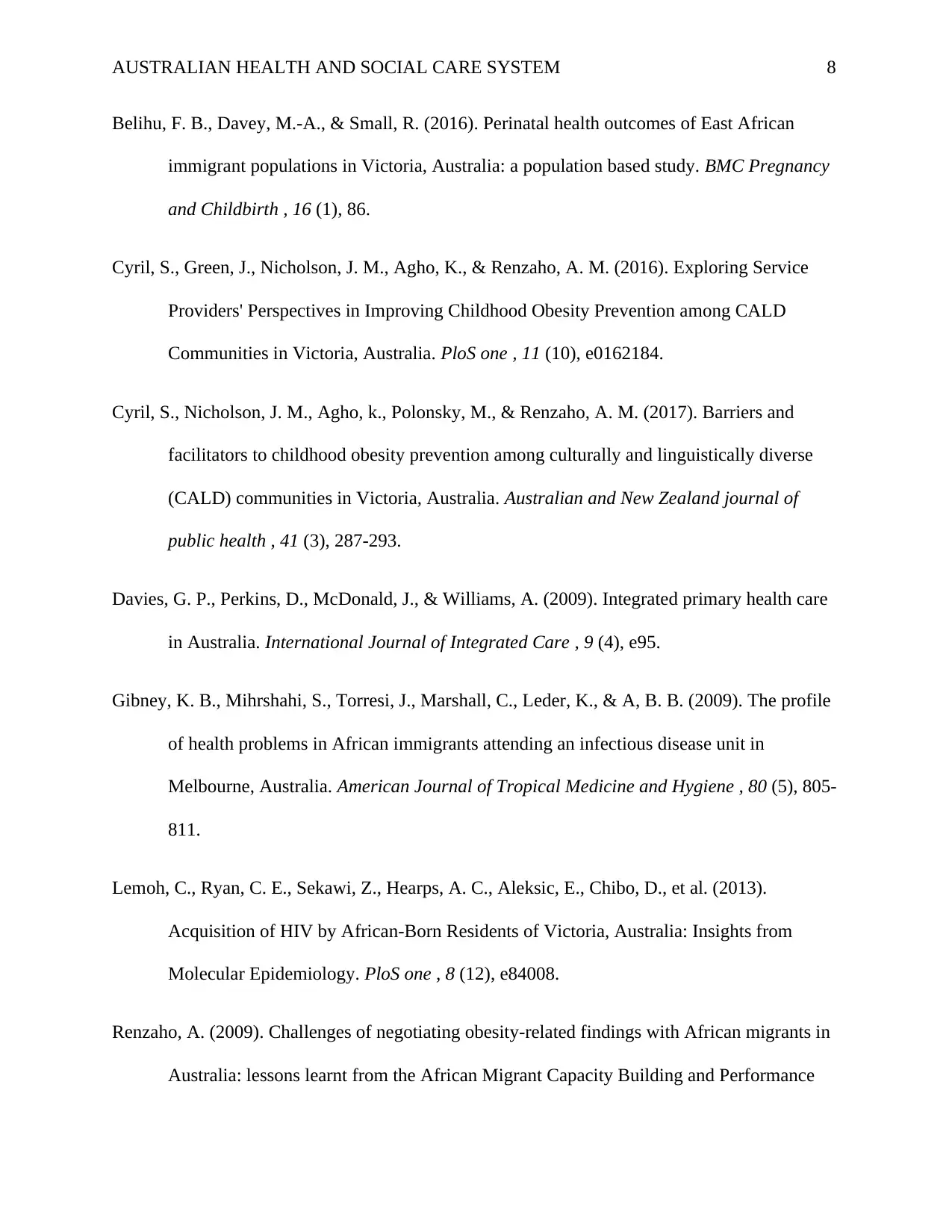
AUSTRALIAN HEALTH AND SOCIAL CARE SYSTEM 8
Belihu, F. B., Davey, M.-A., & Small, R. (2016). Perinatal health outcomes of East African
immigrant populations in Victoria, Australia: a population based study. BMC Pregnancy
and Childbirth , 16 (1), 86.
Cyril, S., Green, J., Nicholson, J. M., Agho, K., & Renzaho, A. M. (2016). Exploring Service
Providers' Perspectives in Improving Childhood Obesity Prevention among CALD
Communities in Victoria, Australia. PloS one , 11 (10), e0162184.
Cyril, S., Nicholson, J. M., Agho, k., Polonsky, M., & Renzaho, A. M. (2017). Barriers and
facilitators to childhood obesity prevention among culturally and linguistically diverse
(CALD) communities in Victoria, Australia. Australian and New Zealand journal of
public health , 41 (3), 287-293.
Davies, G. P., Perkins, D., McDonald, J., & Williams, A. (2009). Integrated primary health care
in Australia. International Journal of Integrated Care , 9 (4), e95.
Gibney, K. B., Mihrshahi, S., Torresi, J., Marshall, C., Leder, K., & A, B. B. (2009). The profile
of health problems in African immigrants attending an infectious disease unit in
Melbourne, Australia. American Journal of Tropical Medicine and Hygiene , 80 (5), 805-
811.
Lemoh, C., Ryan, C. E., Sekawi, Z., Hearps, A. C., Aleksic, E., Chibo, D., et al. (2013).
Acquisition of HIV by African-Born Residents of Victoria, Australia: Insights from
Molecular Epidemiology. PloS one , 8 (12), e84008.
Renzaho, A. (2009). Challenges of negotiating obesity-related findings with African migrants in
Australia: lessons learnt from the African Migrant Capacity Building and Performance
Belihu, F. B., Davey, M.-A., & Small, R. (2016). Perinatal health outcomes of East African
immigrant populations in Victoria, Australia: a population based study. BMC Pregnancy
and Childbirth , 16 (1), 86.
Cyril, S., Green, J., Nicholson, J. M., Agho, K., & Renzaho, A. M. (2016). Exploring Service
Providers' Perspectives in Improving Childhood Obesity Prevention among CALD
Communities in Victoria, Australia. PloS one , 11 (10), e0162184.
Cyril, S., Nicholson, J. M., Agho, k., Polonsky, M., & Renzaho, A. M. (2017). Barriers and
facilitators to childhood obesity prevention among culturally and linguistically diverse
(CALD) communities in Victoria, Australia. Australian and New Zealand journal of
public health , 41 (3), 287-293.
Davies, G. P., Perkins, D., McDonald, J., & Williams, A. (2009). Integrated primary health care
in Australia. International Journal of Integrated Care , 9 (4), e95.
Gibney, K. B., Mihrshahi, S., Torresi, J., Marshall, C., Leder, K., & A, B. B. (2009). The profile
of health problems in African immigrants attending an infectious disease unit in
Melbourne, Australia. American Journal of Tropical Medicine and Hygiene , 80 (5), 805-
811.
Lemoh, C., Ryan, C. E., Sekawi, Z., Hearps, A. C., Aleksic, E., Chibo, D., et al. (2013).
Acquisition of HIV by African-Born Residents of Victoria, Australia: Insights from
Molecular Epidemiology. PloS one , 8 (12), e84008.
Renzaho, A. (2009). Challenges of negotiating obesity-related findings with African migrants in
Australia: lessons learnt from the African Migrant Capacity Building and Performance
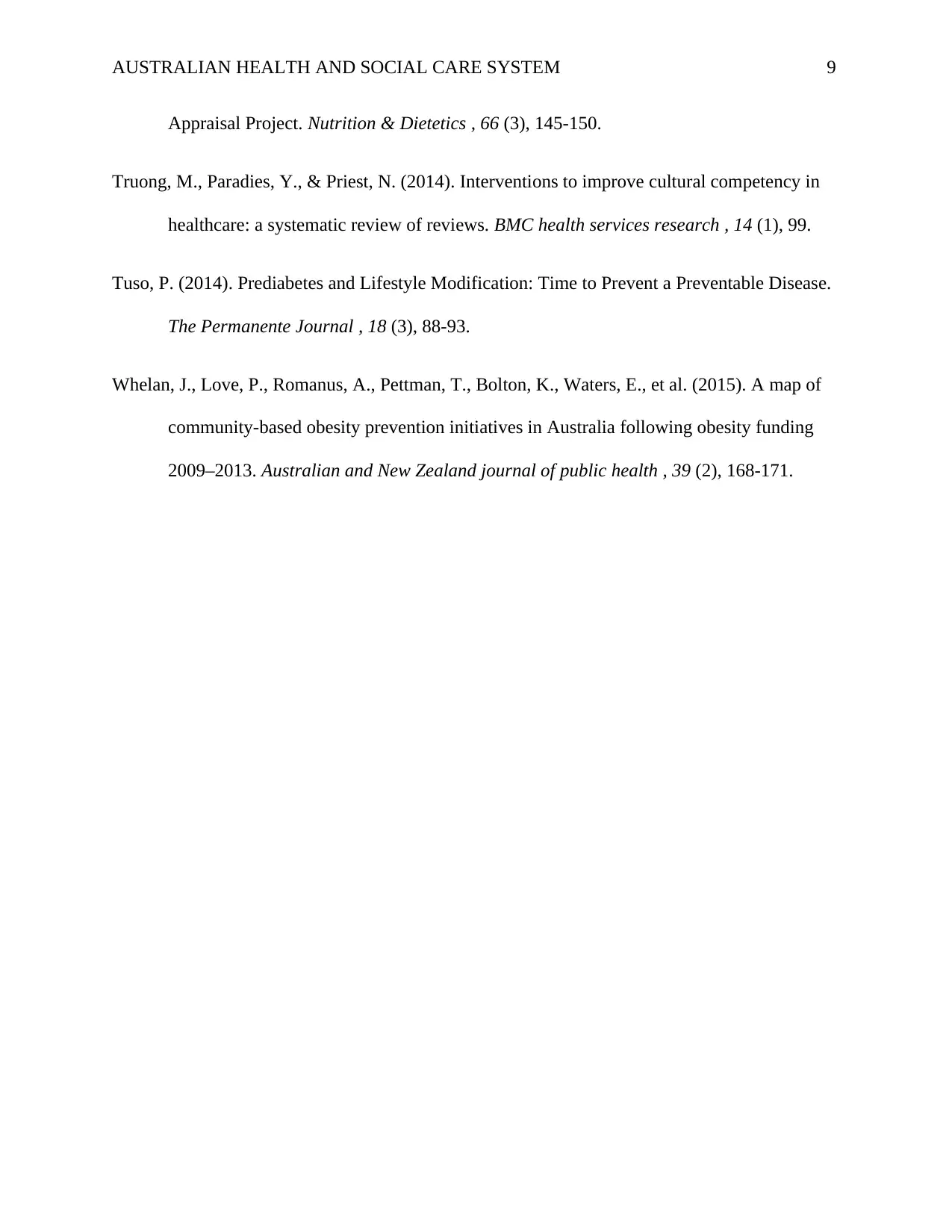
AUSTRALIAN HEALTH AND SOCIAL CARE SYSTEM 9
Appraisal Project. Nutrition & Dietetics , 66 (3), 145-150.
Truong, M., Paradies, Y., & Priest, N. (2014). Interventions to improve cultural competency in
healthcare: a systematic review of reviews. BMC health services research , 14 (1), 99.
Tuso, P. (2014). Prediabetes and Lifestyle Modification: Time to Prevent a Preventable Disease.
The Permanente Journal , 18 (3), 88-93.
Whelan, J., Love, P., Romanus, A., Pettman, T., Bolton, K., Waters, E., et al. (2015). A map of
community-based obesity prevention initiatives in Australia following obesity funding
2009–2013. Australian and New Zealand journal of public health , 39 (2), 168-171.
Appraisal Project. Nutrition & Dietetics , 66 (3), 145-150.
Truong, M., Paradies, Y., & Priest, N. (2014). Interventions to improve cultural competency in
healthcare: a systematic review of reviews. BMC health services research , 14 (1), 99.
Tuso, P. (2014). Prediabetes and Lifestyle Modification: Time to Prevent a Preventable Disease.
The Permanente Journal , 18 (3), 88-93.
Whelan, J., Love, P., Romanus, A., Pettman, T., Bolton, K., Waters, E., et al. (2015). A map of
community-based obesity prevention initiatives in Australia following obesity funding
2009–2013. Australian and New Zealand journal of public health , 39 (2), 168-171.
⊘ This is a preview!⊘
Do you want full access?
Subscribe today to unlock all pages.

Trusted by 1+ million students worldwide
1 out of 9
Your All-in-One AI-Powered Toolkit for Academic Success.
+13062052269
info@desklib.com
Available 24*7 on WhatsApp / Email
![[object Object]](/_next/static/media/star-bottom.7253800d.svg)
Unlock your academic potential
Copyright © 2020–2025 A2Z Services. All Rights Reserved. Developed and managed by ZUCOL.


